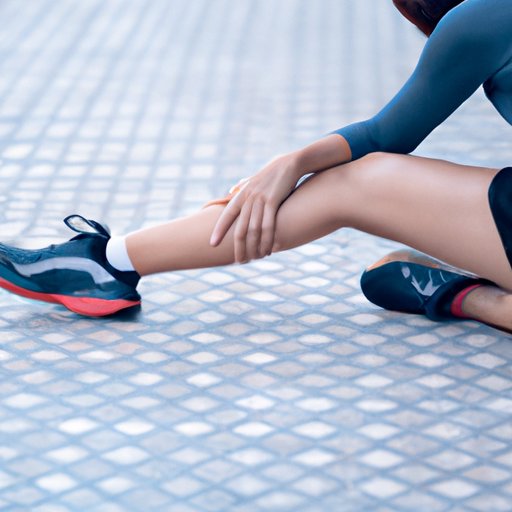Introduction
Feeling sore after a workout is a common experience, but it’s not always clear why your body is reacting in this way. If your legs are feeling sore after a workout, you may be wondering what’s causing the pain and what you can do to reduce it. This article will explore the potential reasons why your legs might be sore after working out, and provide some tips on how to reduce post-workout soreness and prevent it from happening in the future.
Investigating the Causes of Soreness After a Workout
When it comes to post-workout soreness, there are several possible causes, including overuse injury, poor form and technique, lack of warm-up, intensity of the workout, and dehydration. Let’s look at each of these in more detail.
Overuse Injury
One of the most common causes of post-workout soreness is an overuse injury. This occurs when you put too much stress on your muscles or joints by doing too much too soon. Overuse injuries can range from minor aches and pains to more serious issues such as tendonitis or stress fractures. It’s important to listen to your body and take breaks if necessary, as pushing through the pain can lead to further injury.
Poor Form and Technique
If you’re using poor form and technique while exercising, this can also cause soreness after a workout. Poor form and technique can lead to imbalances in your muscles, leading to uneven strain and discomfort. Make sure to use correct form and technique when performing any exercise to help reduce the risk of injury.
Lack of Warm-Up
Warming up before a workout helps to prepare your body for exercise by increasing blood flow, raising your heart rate, and loosening up your muscles. If you don’t warm-up properly, your muscles won’t be as prepared for the workout and can become strained. To help reduce post-workout soreness, make sure to include a warm-up as part of your routine.
Intensity of the Workout
The intensity of your workout can also have an impact on post-workout soreness. If you’re pushing yourself too hard, your muscles may not be able to handle the stress and can become strained and sore. Make sure to adjust the intensity of your workouts to your fitness level to help reduce the risk of injury.
Dehydration
Dehydration can also be a factor in post-workout soreness. When you exercise, your body loses fluids, which can lead to dehydration if you don’t replenish them. Dehydration can cause your muscles to become weak and can lead to cramps and aches. Make sure to drink plenty of water before, during, and after your workouts to help keep your body hydrated.
What You Should Know About Post-Workout Leg Soreness
Post-workout leg soreness is usually nothing to worry about and should go away on its own within a few days. However, there are some symptoms that you should look out for that could indicate a more serious issue. These include persistent pain, swelling, redness, or difficulty walking.
How to Reduce Post-Workout Leg Soreness
There are several steps you can take to reduce the risk of post-workout leg soreness. These include proper hydration, warming up before exercise, appropriate intensity, good form and technique, and understanding delayed onset muscle soreness (DOMS). Let’s look at each of these in more detail.
Proper Hydration
Staying hydrated is essential for reducing the risk of post-workout soreness. Before, during, and after your workout, make sure to drink plenty of water to keep your body hydrated. If you’re exercising for longer than an hour, consider drinking a sports drink to replace electrolytes.
Warm-Up Before Exercise
Warming up before a workout helps to prepare your body for exercise by increasing blood flow, raising your heart rate, and loosening up your muscles. Make sure to include a warm-up as part of your routine to help reduce the risk of post-workout soreness.
Appropriate Intensity
The intensity of your workout can also have an impact on post-workout soreness. Make sure to adjust the intensity of your workouts to your fitness level to help reduce the risk of injury.
Good Form and Technique
Using correct form and technique when performing any exercise helps to reduce the risk of injury and post-workout soreness. Make sure to focus on your form and technique to ensure you’re getting the most out of your workout and minimizing the risk of injury.
Understanding Delayed Onset Muscle Soreness (DOMS)
Delayed onset muscle soreness (DOMS) is a type of muscle soreness that typically occurs 24-48 hours after a workout. It is caused by microscopic tears in the muscle fibers that occur during exercise. Symptoms of DOMS include muscle stiffness, tenderness, and soreness. The best way to treat DOMS is to rest, stretch, and apply heat or cold therapy.
The Benefits of Stretching for Post-Workout Leg Soreness
Stretching can help to reduce post-workout leg soreness by improving flexibility, reducing the risk of injury, and increasing range of motion. Make sure to include stretching as part of your post-workout routine to help reduce the risk of soreness and injury.
Conclusion
Post-workout leg soreness is a common problem, but it doesn’t have to be something you just accept. By understanding the possible causes of post-workout soreness and taking measures to reduce it, you can help to keep your legs healthy and comfortable after a workout. Proper hydration, warm-up, appropriate intensity, good form and technique, and understanding delayed onset muscle soreness (DOMS) can all help to reduce the risk of post-workout soreness. Additionally, including stretching as part of your post-workout routine can help to improve flexibility, reduce the risk of injury, and increase range of motion. Taking care of your muscles after exercise is key to staying healthy and avoiding injury.
(Note: Is this article not meeting your expectations? Do you have knowledge or insights to share? Unlock new opportunities and expand your reach by joining our authors team. Click Registration to join us and share your expertise with our readers.)
